For the 2025 school year, there is 1 public preschool serving 280 students in North Panola School District.
Public Preschools in North Panola School District have a diversity score of 0.14, which is less than the Mississippi public preschool average of 0.60.
Minority enrollment is 98% of the student body (majority Black), which is more than the Mississippi public preschool average of 55% (majority Black).
Overview
This School District
This State (MS)
# Schools
6 Schools
282 Schools
# Students
1,155 Students
125,600 Students
# Teachers
93 Teachers
10,006 Teachers
Student : Teacher Ratio
13:1
13:1
District Rank
North Panola School District, which is ranked within the bottom 50% of all 148 school districts in Mississippi (based off of combined math and reading proficiency testing data) for the 2021-2022 school year.
The school district's graduation rate of 85-89% has increased from 80-84% over five school years.
Overall District Rank
#136 out of 148 school districts
(Bottom 50%)
(Bottom 50%)
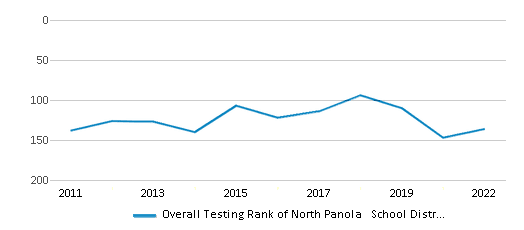
Math Test Scores (% Proficient)
20%
47%
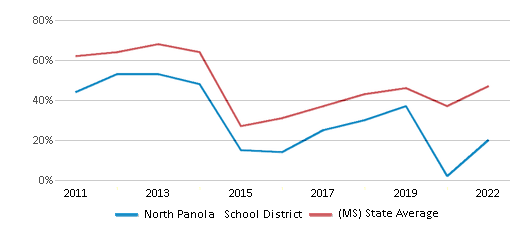
Reading/Language Arts Test Scores (% Proficient)
17%
42%
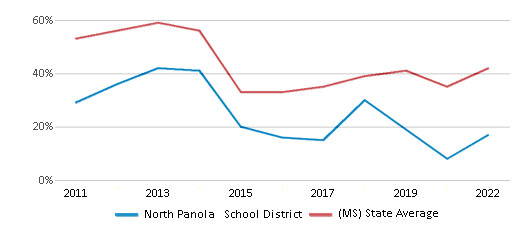
Science Test Scores (% Proficient)
39%
55%

Graduation Rate
85-89%
89%
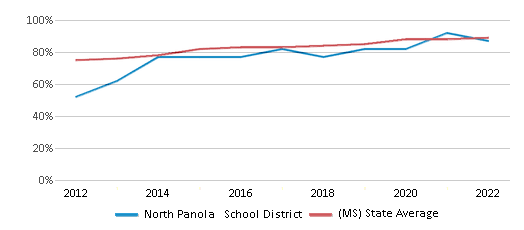
Students by Ethnicity:
Diversity Score
0.09
0.60
# American Indian Students
n/a
282 Students
% American Indian Students
n/a
n/a
# Asian Students
1 Student
834 Students
% Asian Students
n/a
1%
# Hispanic Students
4 Students
5,432 Students
% Hispanic Students
n/a
4%
# Black Students
1,102 Students
56,691 Students
% Black Students
96%
45%
# White Students
32 Students
55,982 Students
% White Students
3%
45%
# Hawaiian Students
3 Students
66 Students
% Hawaiian Students
n/a
n/a
# Two or more races Students
13 Students
6,313 Students
% of Two or more races Students
1%
5%
Students by Grade:
# Students in PK Grade:
18
9,221
# Students in K Grade:
84
22,360
# Students in 1st Grade:
84
22,172
# Students in 2nd Grade:
87
19,400
# Students in 3rd Grade:
104
14,702
# Students in 4th Grade:
85
13,066
# Students in 5th Grade:
65
10,676
# Students in 6th Grade:
98
4,243
# Students in 7th Grade:
88
1,742
# Students in 8th Grade:
74
1,709
# Students in 9th Grade:
96
1,025
# Students in 10th Grade:
117
986
# Students in 11th Grade:
74
953
# Students in 12th Grade:
72
827
# Ungraded Students:
9
2,518
District Revenue and Spending
The revenue/student of $15,144 is higher than the state median of $12,205. The school district revenue/student has grown by 18% over four school years.
The school district's spending/student of $13,177 is higher than the state median of $12,074. The school district spending/student has grown by 18% over four school years.
Total Revenue
$18 MM
$5,371 MM
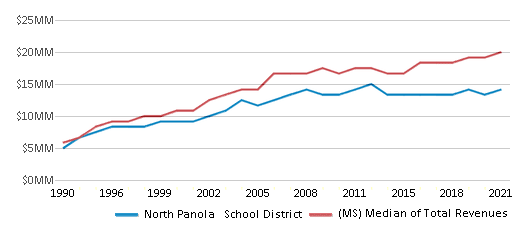
Spending
$15 MM
$5,314 MM
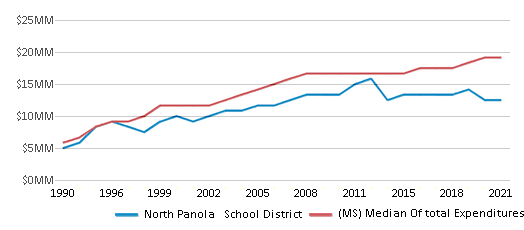
Revenue / Student
$15,144
$12,205
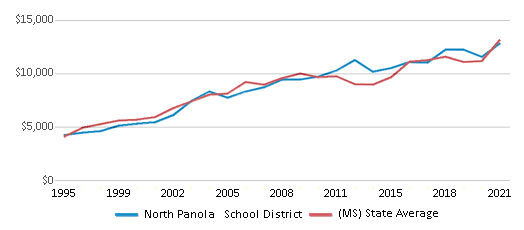
Spending / Student
$13,177
$12,074

Best North Panola School District Public Preschools (2025)
School
(Math and Reading Proficiency)
(Math and Reading Proficiency)
Location
Grades
Students
Rank: #11.
Como Primary
(Math: 30-34% | Reading: 20-24% )
Rank:
Rank:
4/
Bottom 50%10
200 Lewers Drive
Como, MS 38619
(662) 526-0396
Como, MS 38619
(662) 526-0396
Grades: PK-2
| 280 students
Recent Articles

Year-Round Or Traditional Schedule?
Which is more appropriate for your child? A year-round attendance schedule or traditional schedule? We look at the pros and cons.

Why You Should Encourage Your Child to Join a Sports Team
Participating in team sports has a great many benefits for children, there is no doubt. In this article you will learn what those benefits are.

White Students are Now the Minority in U.S. Public Schools
Increasing birth rates among immigrant families from Asia and Central and South America, combined with lower birth rates among white families, means that for the first time in history, public school students in the United States are majority-minority. This shift in demographics poses difficulties for schools as they work to accommodate children of varying language abilities and socio-economic backgrounds.





